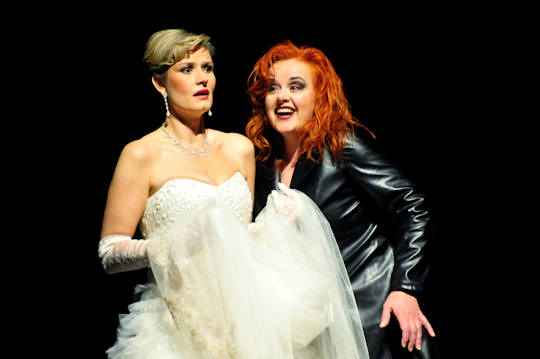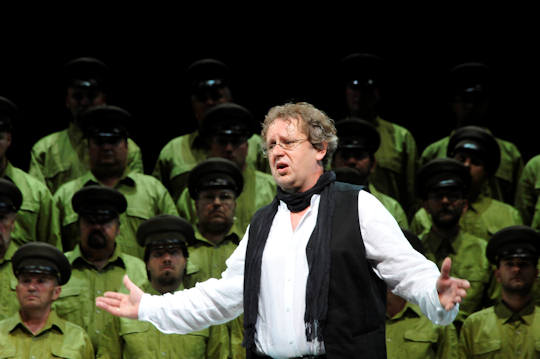‘Wagner in Budapest ‘ Opera Festival 2011 (1) Wagner, Lohengrin: Soloists, Honved Male Choir, Budapest Studio Choir, MR Choir, orchestra of the Hungarian State Opera. Conductor: Ádám Fischer. Béla Bartók Concert Hall, Palace of Arts, Budapest, 9.6.2011. (JPr)

Since their inauguration in 2006 the Budapest Wagner Days have added a new semi-staged opera production to their repertoire each year. Following the staging in previous years of the Ring, Parsifal and Tristan, this year the collaboration with Hungarian State Opera was Lohengrin.
The publicity states ‘Year after year, musical director Ádám Fischer is able to attract the top Wagnerian singers to the series, which can be described without exaggeration as the Hungarian answer to Bayreuth’. Quite a claim but it is – to a degree – worthy, especially because of the mightily impressive auditorium where the performances take place, the excellent orchestra, stunning acoustics and generally well prepared performances.
Firstly a mention – before discussing Lohengrin – about the venue; the concert hall is in the Palace of Arts an ultra-modern cultural complex on the Pest side of the Danube and was opened in 2005. It boasts ‘state-of-the-art technology’ and is constructed as ‘a box within a box sitting on rubber springs to eliminate all external noise’ (but not the hum of the air-conditioning unfortunately). The acoustics were engineered by a New York firm of consultants and can be fine-tuned for the event by an adjustable canopy above the stage and various resonance chambers. The organ is apparently the largest of any concert hall in Europe and was used to great effect at certain moments during Lohengrin such as at the end of Act II as the cathedral welcomes the bridal pair.
It all mimics Bayreuth in other ways too, such as lengthy intervals approaching an hour each, though unlike at the Festspielhaus there is little scenery to change. Also different from that famous festival is the number of empty seats: it appears that not enough Wagnerians are yet aware of the musical delights the wonderful city of Budapest now has to offer. When the audience takes their seats it is immediately clear we are not in an opera house as there is no proscenium arch or curtains. There is a sunken orchestra pit however and though the printed programme did not give any details of it, there seemed room for about 70 musicians; more than enough to provide – due to the hall’s tailored acoustics – plush ‘sensurround’ Wagner which was aided by having the trumpet calls from the organ loft high up at the front.
After the sudden death of Giuseppe Sinopoli in 2001, Ádám Fischer made his debut at Bayreuth as his replacement and conducted Ring Cycles there and was chosen as ‘The conductor of the year 2002’ by the German magazine Opernwelt. He conducted the Ring for a further two years and returned to the Green Hill for Parsifal in 2006 and 2007. In 2007 he was appointed general music director of the Hungarian State Opera. He is therefore a very experienced Wagner conductor but what was most impressive was that this Lohengrin (and the subsequent Tristan which i will report separately) had not been ‘cobbled together’. Fischer and his musical assistants had carefully prepared – not just the orchestra – but the soloists so that together they gave not thoughtful and musically precise performances where every note was given its true value and colour, and also sang every phrase with a clear understanding of the meaning of the words, even if they were not singing in their first language.

This was a semi-staging because of the lack of depth to the performance area and it was a typical updating of the Lohengrin story; I don’t know when László Marton first came up with his concept but for me it drew heavily on the current Neuenfels staging at Bayreuth, though without the rats! In a few explanatory words from the director in the programme we read how ‘ Lohengrin comes from another world … He is a poet enshrouded in a poetic veil, illuminated with a strange light. He is a complete stranger in the strong, militant world of Brabant … (his) appearance causes this militant and military world to change, the dark colours in the music to lighten. Given a grey-uniformed Maoian world at the beginning of the opera, with the entrance of Lohengrin … the hope of a shining and colourful world arises … Elsa contradicts her own wishes because she is unable to make any change, being so strongly determined by Brabantian militantism.’
A stark grey set (designed by Péter Horgas) dominated and melded into either side of the rear of the ‘stage’ with the utilitarian look of a concrete East-European Presidential palace. The ‘Brabantians’ in full military uniform, are seated on bleachers with 10 mirrored panels behind them. There is the metal frame of a throne in the centre that acts both as a seat and as the podium from where King Henry – or ‘the President’ – addresses his people and beseeches God to save his people from ‘the Hungarian hordes’. (Given the murmuring in the hall, this was something that did not go down too well with the locals when they read the translation at this point!)
The darkly veiled figure of Elsa makes a dramatic entrance from the back of the stalls but the arrival of Lohengrin is a rather amateurish affair involving a reassembling of the mirrored panels to give an impression of wings at the point where he sings farewell to the swan, while gazing at his own reflection. On his arrival the men and women on stage lose their drab garments to reveal garishly pastel clothes. (This is a very similar to what happens in Bayreuth where there is a equally sterile laboratory environment plus ‘rats’ who lose their costumes and are then are dressed in bright yellow.) The fight between Lohengrin and Telramund is a too-often seen risible slow-motion event on a light box at the front of the stage. In Act III the mirrored panels surround the large bed for the newly married couple which is also illuminated from below. Having suffered at airport security on my flight out to Budapest, I could only smile wryly at the soberly-suited protection detail complete with sniffer dogs and metal detector which came on stage to check that all was well on the wedding day and the wedding night.
No money had obviously been spared on the elegant costumes designed by Mari Benedek for the principals, especially the women. Ortrud was fearsomely dressed in what looked like a black leather trouser suit when she takes centre-stage in Act II and later when she appears in a gorgeous black feathered gown somewhat mimicking Elsa’s white wedding dress. This ‘white swan’/’black swan’ idea – as well as the costumes – also seemed lifted from the Bayreuth Lohengrin. The ‘swan knight’ himself was rather less the shining hero and more a penniless itinerant musician when he came on stage dressed like a mature student, curly-haired with glasses and a violin case on his shoulder. All that was in the music case howevr was a simple horn for the young Gottfried which he brings back on stage at the end of the opera to become the true ruler of Brabant. Gottfried was played by a very fidgety young boy clearly unsure of what was going on.
I thought it would be difficult to surpass the overall quality of performance that Semyon Bychkov and his cast gave at Covent Garden in 2009 but this Lohengrin was even better musically. There was however the same ‘stand and deliver’ quality about the singing as at Covent Garden although this production had the excuse that when the platform was full there was really no where else to go. Here in Budapest we had a superior Elsa from Camilla Nylund who went from the dreamy fragility of ‘Einsam in trüben Tagen’ to a single minded steeliness for her Act III ‘Ach! Könnt’ ich deiner werth erscheinen!’ while demanding the answers to her questions. She was more than well-matched by the imperious Ortrud of Petra Lang. Her character has little to do in Act I apart from supporting her husband Telramund’s charges of fratricide against Elsa. But in Act II with flaming red hair and chilling smile she is evil personified and there is always a suppressed rage bubbling away even during the passages when she wheedles her way back into Elsa’s ‘good books’. It is in the triumphant paean to her pagan gods in Act II and the hysteria at the end of Act III however when she really comes into her own. Her voice – which has previously plumbed great malevolent contralto-like depths – now reaches the stratospheric heights of a great dramatic soprano. It was a bit kitsch of her to hold out her right hand as she called for ‘Wodan!’ and then to gesture with her left hand for ‘Freia!’ during ‘Entweihte Götter!’ but those experiencing such moments will not forget them quickly. It is unlikely that anyone betters Petra Lang as Ortrud among the current generation of singers, to my mind, and those who see her in this role next month in Bayreuth will hopefully agree with me.
Béla Perencz sang powerfully and often so eloquently that he almost elicited an unusual sympathy for Telramund. Michael Nagy (Wolfram soon at Bayreuth) was a strong Herald, Alfred Muff a slightly venerable King Henry but the revelation amongst the male singers was István Kovácsházi’s Lohengrin which deserves to be much better known. Off stage the tenor looked as nondescript as he did on stage so maybe that is the reason for his relatively limited reputation but here none of that mattered because his singing was exactly what this ‘poet’ needed. His voice took on the colours of a counter-tenor for his initial ‘Nun sei bedankt, mein lieber Schwan!’ and I wondered whether he would get through the challenges of the evening. He did so magnificently revealing along the way a tireless voice with a bright tone and metallic top notes.
Jim Pritchard